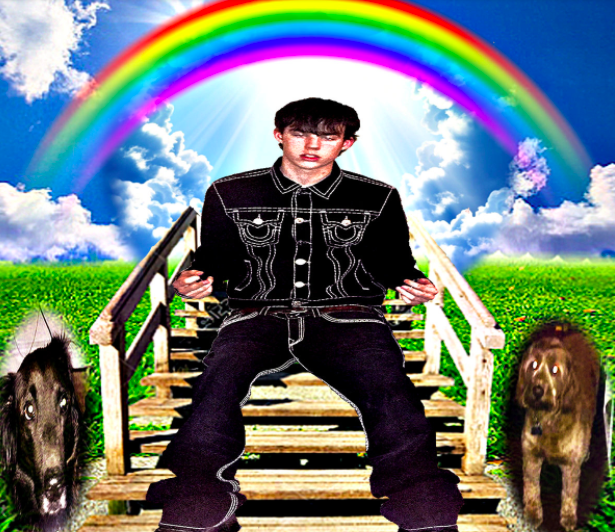Understanding Sematary’s musical necromancy
By Liam Dwyer, ‘22
This California rapper blends noisy rock and trap through a horrorcore lens.
Every so often, I stumble upon a genre or an artist that I would never have expected to click for me. Most recently, it’s been Jazz Fusion from the 1980s.
However, no artist has intrigued or surprised me as much as Sematary. With compressed and distorted vocals; lyrics that focus heavily on horror imagery, energy drinks, and True Religion jeans; black metal samples; and production taking equally from trap and witch house (I’ll circle back to that), Sematary creates a unique atmosphere that bombards your eardrums.
I first got into Sematary through his most recent mixtape, “Rainbow Bridge 3.” Of the trilogy of Rainbow Bridge mixtapes, it is by far the most grating, noisy, and chaotic.
Sematary doesn’t cater to a quieter sound. His music is meant to be blasted out of car speakers or listened to with headphones at full volume.
Catlin Gabel School (CGS) senior, who wished to remain anonymous, got into Sematary through internet memes on TikTok.
“It was a little grating at first, but I went back to it, and it grew on me,” they said.
“It’s strangely melodic. He’s working with the beat, but in other parts, the music is really loud and grating, and he’s working with that,” explained this senior.
Luna Simon, a longtime fan, found Sematary through his Tumblr blog while scrolling through their feed in mid-2019.
“It was incredibly different from everything else I’d been listening to. I didn’t quite understand what was going on, but I really enjoyed the sound,” she said.
One genre that Sematary takes inspiration from is horrorcore, a genre defined by violent, horror-themed lyrics.
The senior knew of some horrorcore artists, like Insane Clown Posse, but only loosely. “If you listen to him and Insane Clown Posse, he definitely takes more inspiration from trap than [their music, which is] hip hop,” he said.
Another horror-inspired genre Sematary is influenced by is witch house, which fuses shoegaze, synthpop, and southern hip hop styles with folk horror and occult imagery. At its inception in the late 2000s, it saw some popularity but mostly faded into obscurity.
There were other inspirations the senior noticed in Sematary’s music as well: “Chief Keef, for sure. It’s heavy metal Chief Keef, which is an interesting combo, but it works well.”
Chief Keef frequently makes trap music, a genre of hip-hop characterized by 808 drum kicks and sophisticated hi-hat patterns that emerged in the American South in the 90s, which is one large influence of Sematary’s music. Trap music culture is also where True Religion brand jeans were most popular; something Sematary pays homage to in songs like “Truey Jeans.”
Sematary wears True Religion on the cover of his “Rainbow Bridge” tape.
Sematary’s lyricism has a unique quality to it. It’s rare to find an artist who has name-dropped everything from David Lynch’s “Twin Peaks” (“Deer God”) to “The Texas Chainsaw Massacre” (“Skin Mask”), but also “Lord of the Rings” (“Interstate”), “Toy Story” (“Chandelier”), and “Watership Down” (“Bunny Suit”).
The senior noted that “horrorcore has been done before, but he’s branched off. He’s out at the front for the genre he’s created.”
Simon spoke on Sematary’s style as well: “The genre is very unique, but he does not like it being a genre. He just wants it to be his music.”
There’s some hypocrisy to that desire. Haunted Mound, a collective started by Sematary and frequent collaborator Ghost Mountain, includes many rappers who fit into a sound similar to Sematary, though many have yet to release much music.
Furthermore, artists not in Haunted Mound exploring Sematary’s style have faced criticism from both the artist and his fanbase.
Editor’s Note: This article was edited on May 23, 2025 to anonymize a source at their request.
A recent tweet by Sematary takes shots at his counterparts.
“It’s messed up to put them in that box of… ‘oh, you can’t make anything else,’” said Simon.
They’re currently working with one of these artists, Salvador, on making merchandise.
Simon’s final remark on Sematary ‘clones’ was this: “He doesn’t like people taking inspiration from him, yet he takes all this inspiration [from others].”
“If other people are inspired, then they’re inspired. Let them do what they want.”
Sematary’s new album, “Screaming Forest”, is available on Soundcloud, Spotify, and Bandcamp.


